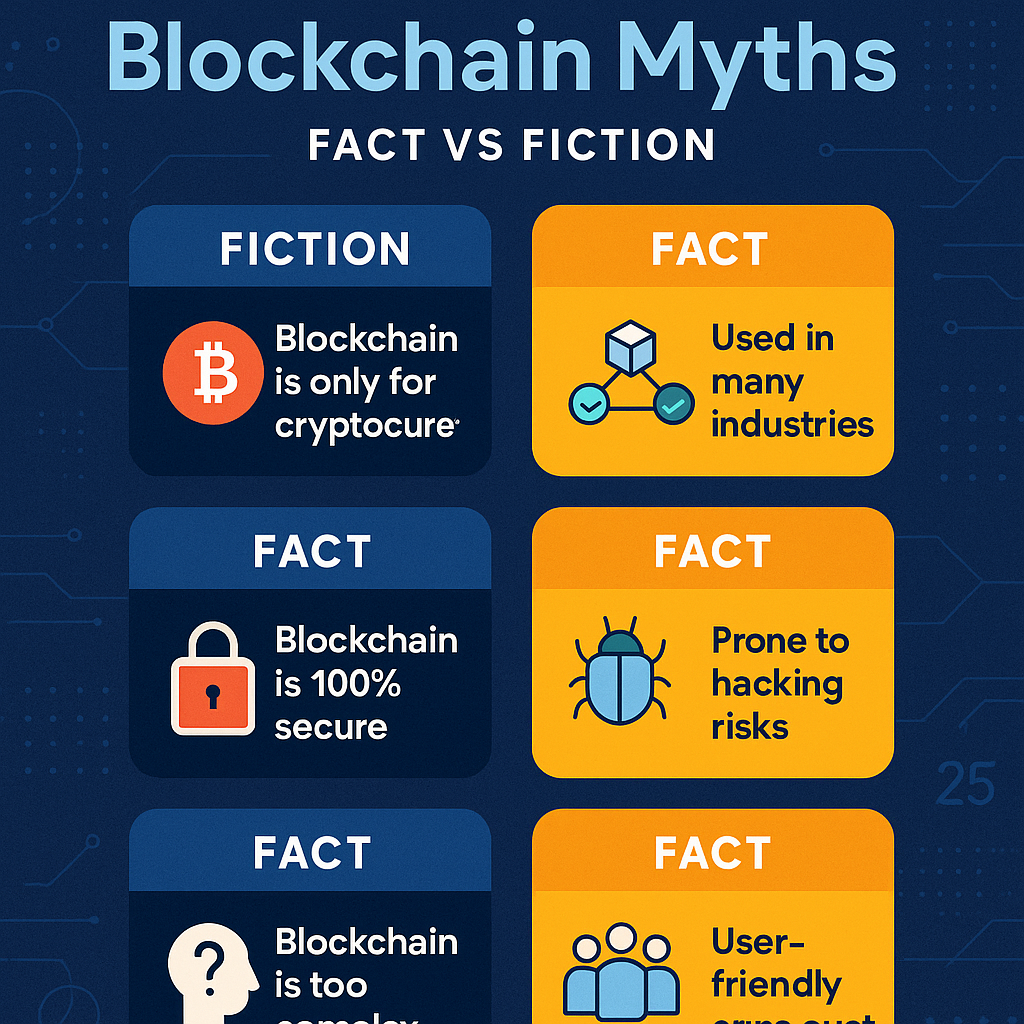Is blockchain just a buzzword for cryptocurrency scams, or is it really unhackable? If you’ve ever felt confused by the hype around blockchain, you’re not alone—there’s a lot of misinformation out there. In 2025, it’s time to set the record straight by debunking blockchain myths. From the idea that blockchain is only for crypto to the belief that it’s too complex for everyday use, this guide tackles the biggest blockchain misconceptions with facts and real-world examples. Let’s clear up the confusion and uncover the truth together!

Table of Contents
Why Blockchain Myths Persist in 2025
Blockchain technology has been around since Bitcoin’s launch in 2009, but myths still linger—often fueled by media hype and early scandals. A 2025 survey by Deloitte found that 40% of people still associate blockchain solely with cryptocurrency, despite its use in industries like finance and healthcare. Misinformation spreads because blockchain can seem complex, and early challenges like high energy use have left lasting impressions.
I used to think blockchain was just for crypto traders until I saw it in action at a local supply chain event—more on that later. Let’s dive into debunking blockchain myths and get to the truth.
For blockchain basics, start with our Blockchain 101 guide.
Myth 1: Blockchain Is Only for Cryptocurrencies
One of the biggest blockchain misconceptions is that it’s only for cryptocurrencies like Bitcoin. While blockchain started with crypto, its applications are vast. In 2025, IBM’s Food Trust blockchain tracks food supply chains for companies like Walmart, reducing tracing time from 7 days to 2.2 seconds, per IBM’s 2025 report. In finance, JPMorgan’s Onyx platform processes $6 trillion in daily payments, according to their annual report.
At that supply chain event I mentioned, I saw Walmart demo how they trace a mango’s journey from farm to store in seconds—it blew my mind! Blockchain is about secure, transparent data, not just crypto.
Explore more applications in our 2025 blockchain use cases.
Myth 2: Blockchain Is Unhackable
Many believe blockchain is unhackable because of its decentralized design—but that’s not entirely true. While blockchains like Bitcoin are secure (no successful 51% attack in its history, per a 2025 Messari report), vulnerabilities exist. In 2024, hackers stole $1.7 billion from DeFi platforms due to smart contract bugs, according to Chainalysis.
A friend who works in cybersecurity told me about a DeFi hack where a poorly coded smart contract let attackers drain $10 million. Blockchain’s security is strong, but it’s not foolproof—coding matters!
Learn more about blockchain security in our Proof of Work vs Proof of Stake guide.
Myth 3: Blockchain Is Too Complex for Everyday Use
Some think blockchain is too complicated for regular people, but 2025 is proving that wrong. User-friendly apps are making blockchain accessible—MetaMask, a blockchain wallet, has 30 million users, per ConsenSys 2025 data. In finance, apps like RippleNet allow instant global payments with a few clicks, processing 1,500 transactions per second (TPS), per Ripple’s metrics.
I used a blockchain app to send money to a friend in Asia last year—it was as easy as using Venmo, but faster and cheaper. Blockchain is becoming part of everyday tech, not just for coders.
For more on blockchain in finance, see our blockchain in finance guide.
Myth 4: Blockchain Is Bad for the Environment
Blockchain’s energy use, especially Bitcoin’s Proof of Work (PoW), has been criticized—Bitcoin consumed 150 terawatt-hours in 2024, per the Cambridge Bitcoin Electricity Consumption Index. But not all blockchains are energy hogs. Proof of Stake (PoS) blockchains like Ethereum use 99.95% less energy since its 2022 upgrade, down to 2.6 gigawatt-hours per year, per Digiconomist 2025.
I felt guilty mining Bitcoin on my laptop years ago—it overheated fast! But staking ETH now feels eco-friendly. In 2025, 70% of new blockchains use PoS, per Chainalysis, showing a greener future.
Learn about consensus mechanisms in our Proof of Work vs Proof of Stake guide.
Myth 5: Blockchain Lacks Regulation and Oversight
Some believe blockchain operates in a regulatory Wild West, but that’s changing. By 2025, 80% of G20 countries have blockchain regulations, per a World Economic Forum report. The EU’s MiCA framework, implemented in 2024, regulates crypto assets, while the US has expanded SEC oversight, with 500 blockchain companies registered, per SEC 2025 data.
A fintech colleague shared how their blockchain startup complied with MiCA—it took extra paperwork, but it built trust with users. Blockchain is becoming a regulated, legitimate technology.
For more on blockchain trends, visit our Web3 Learning Hub.
The Truth About Blockchain’s Future
In 2025, blockchain is more than crypto—it’s a transformative technology with applications in supply chains, finance, and beyond. It’s secure but not unhackable, user-friendly for everyday use, increasingly eco-friendly, and more regulated than ever. The blockchain facts 2025 show a technology that’s maturing and ready for mainstream adoption.
Let’s keep exploring the truth about blockchain—share this guide with a friend or bookmark it for your journey into this exciting tech world!
Check out more insights on our homepage.
Frequently Asked Questions
Is blockchain only used for cryptocurrencies?
No, blockchain is used in supply chains, finance, and more—like Walmart tracking food in seconds.
Can a blockchain really be hacked?
It’s tough, but not impossible—smart contract bugs caused $1.7 billion in DeFi hacks in 2024.
Is blockchain too complicated for regular people?
Not anymore—apps like MetaMask make it as easy as using a mobile payment app.
Does blockchain always harm the environment?
No, Proof of Stake blockchains like Ethereum use 99.95% less energy than Bitcoin.
Is blockchain completely unregulated?
Not true—80% of G20 countries have blockchain regulations in 2025.
Related Articles
Ready to Explore More Blockchain Truths?
We’ve busted some myths by debunking blockchain myths—but there’s so much more to learn! Dive deeper with our Web3 Learning Hub or subscribe to our newsletter for the latest updates. Let’s keep uncovering the future of blockchain together!
Last updated: April 30, 2025